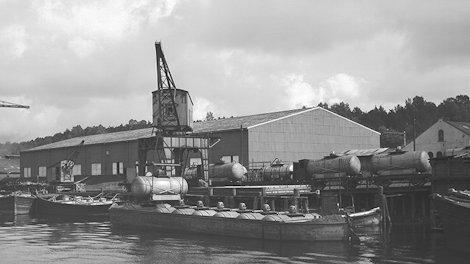In August 1926, the board had given the go-ahead to build an ammonia factory at Notodden. The basis for the decision was an agreement with the American engineering company NEC, which had developed ammonia technology that was as good as the German technology.
Hydro's management meanwhile had other questions on their minds. It was becoming increasingly important to create market positions for fertilizer products - and particularly for nitrogen - as there was a trend towards the formation of cartels in the ammonia market.
Although the work with the American technology seemed promising, there we still many problems to be solved. Hydro's management would have preferred to develop in-house technology and then be able to build a large capacity plant. However the results were not forth-coming.
When Axel Aubert took over from Harald Bjerke as managing director of Hydro in 1927, the company decided to enter a close collaboration with the German company I.G. Farbenindustrie (Farben), which resulted in a considerable extension of the calcium nitrate plants at Rjukan, based on German ammonia technology.
Large prospects on the horizon
On 9 February 1928, the new synthesis plant at Notodden started operation. The technology was mainly American, but several important aspects of the plant had been improved by Hydro's engineers and research scientists. It proved to be very efficient.
The same week, construction work had started at Herøya near Porsgrunn, where factories were to be built with the help of I.G. Farben.
All in all, he work Hydro completed towards the end of the twenties was colossal. The company changed its well-known Norway nitrate production to "Badische calcium nitrate". The factories at Rjukan were converted to the German ammonia process. Major plants were going up at Herøya, and the company's power stations had to be converted from alternating current to direct current. It was all to take place within two years. Altogether there were more than 6000 people involved in these projects.
A party - followed by the depression
In technical terms the projects were a success. On 19 October Hydro set up a long party table at Rjukan for more than 30,000 guests. The managing director, Axel Aubert, who had gone in for a rapid completion of the projects, had every reason to be pleased - and he was.
Blue and white collar workers were invited to the party in a disused factory and were served sausages and beer. It was a great party. Four days later Wall Street crashed.
The change-over in Hydro had been successful, but the market for ammonia was going straight downhill. The crash on Wall Street was soon followed by the beginning of the great depression.
Hydro's major investments could only be written off if the factories ran at full production. There were further negotiations with I.G. Farben, which resulted in an agreement that ensured Hydro sales of at least 83,000 tonnes of nitrogen. That was nearly three times what Hydro was producing in the mid-1920s, and was close to full capacity. I.G. Farben's ammonia production was over five times as high at the beginning of the thirties.
Protectionism
As a result of the difficult market, nitrate producers tried to restrict competition and sought collaboration. Hydro joined forces with I.G. Farben and the British company ICI. It was known as the DEN cooperation (Deutschland - England - Norway). Other producers formed similar alliances.
During this period, when protectionism was rapidly increasing all over the world, Hydro was more vulnerable than most as its home market was small - only five percent of production was sold in Norway at the beginning of the 1930s.
The following years were difficult. Hydro had to lay off employees. The demand for the company's products remained weak and prices fell. The depression both within Norway and internationally also led to a number of labor conflicts.
The agreement with I.G. Farben was crucial for the sales of Hydro's fertilizer products. But the company struggled all the same, also in terms of financial results. In the financial year 1933/34 Hydro made a loss.
The company's results improved again in the second half of the decade. The nitrogen market revived and Hydro was gradually able to harvest the fruits of its measures to increase efficiency. There were still, however, problems with trade policies and major fluctuations in foreign exchange rates.
In the financial year 1938/39 Hydro made a significant profit. It was decided at the annual general meeting at Notodden that seven per cent dividend should be paid on preference shares and six per cent on ordinary shares.
Nevertheless there was little optimism in the air. A new war started on the continent. Norway was soon to be drawn in.
Updated: August 18, 2020






